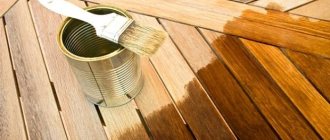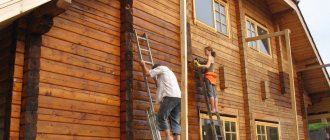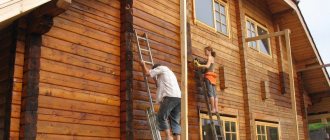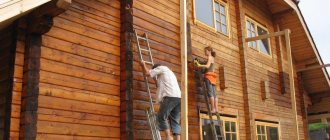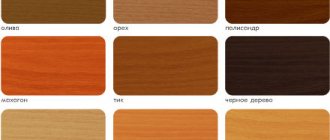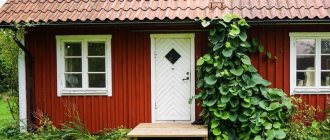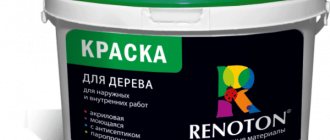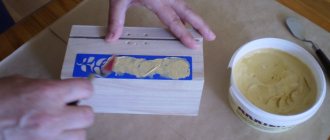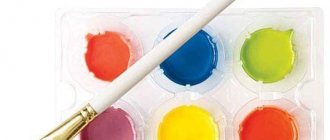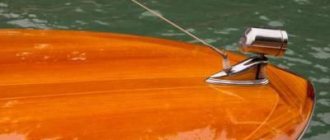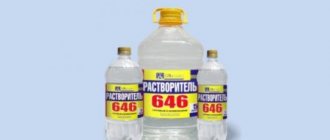Characteristics and Features
There are several types of acrylic varnishes for outdoor use. They differ in additives, color, brightness and durability.
The main features of facade varnishes include:
- Low specific gravity. The issue of excess load is acute in houses on stilts and frames.
- High moisture resistance. After drying, the wood varnish looks more like plastic - without pores or channels for water to pass through.
- High elasticity and strength. If water penetrates, the lateral expansion of the wood will not cause cracks.
- Antiseptic properties.
- Fire safety. According to its characteristics, it resembles liquid glass.
- Lifetime. A good wood varnish for exterior use lasts from 10 years.
The main disadvantage is that wood varnishes for exterior use are water-based. This also results in high thermal conductivity. If the house has not been well insulated, the cold from outside will begin to get inside. In addition, the water base can saturate the wood, raising the fibers. You'll have to sand it down after the first coat.
For exterior woodwork, be sure to buy frost-resistant varnish.
“Sauna” and “yacht” compositions lose their qualities when frozen. And since they penetrate deep into the wood, they can destroy the fibers, making the surface loose.
Compared to oil-based varnishes, acrylic for exterior use is almost resistant to wear. It is not washed off by water, and it is practically indestructible.
A brief overview of modern wood staining solutions
Alpina brand colored impregnating glaze
Tikkurila facade paints for wood are represented by a variety of products that have decorative and protective functions.
All products from this manufacturer can be divided into three groups:
- Facade azure.
- Glazing antiseptic.
- Covering protection.
All types of façade glaze are intended for covering log, sawn or planed wooden surfaces. Such compositions can be used to coat heat-treated wood or wood treated with special impregnations.
This type includes products such as Valtti Aquacolor, Valtti Arctic, Valtti Color Extra. Valtti Color can be used to paint all of the above materials, as well as a variety of wooden boards.
All of the above-mentioned surfaces can be treated with similar antiseptics. This group includes Euro Eco Wood and Valtti Color Satin.
Facade painting mixture for wooden surfaces brand Caparol
Finally, covering protection in the form of the Vinha product is used to treat wooden walls or facades that were previously covered with glaze materials.
Caparol facade paint is available in four large varieties, each of which comes in several more specialized formulations.
For example, if we talk about dispersion-based compositions, then this manufacturer has a product for treating wood surfaces of any structure, and there is also a separate type of exterior paint for mineral plasters.
In any case, such mixtures provide good waterproofing and resistance to weather conditions. The difference between products lies mainly in the degree of adhesion to a particular surface.
In addition to water-dispersion coatings, Caparol produces painting mixtures with a silicone resin base, mineral-based, as well as compositions for concrete and cement plasters.
Perfectly fills the texture of the processed material and has high hiding power. Dufa exterior paint coating is resistant to abrasion and other environmental influences. Along with the technological properties, it also gives the building a rather presentable appearance.
Painting mixture for exterior use Dufa brand
Facade paint "Olympus" is suitable for painting both previously treated and new wooden surfaces. The harmless composition with a base of linseed oil and excellent performance characteristics allow it to be used for both façade and interior work. This coating belongs to alkyd compositions. Flaxseed oil plays the role of a wood strengthening agent here.
Painting compositions for facades Alpina is presented in the form of a line of eighteen different products. However, only three products are traditional coatings for wooden facades - dispersion Fassadenweiss, super-resistant Fassadenfarbe, and the universal tinting mixture Colorant.
If we talk about other mixtures from various manufacturers, you will find among them coatings for almost all occasions.
Kinds
Varnish can be single-component or bi-component. In the first, the main substance is acrylic resin. Once hardened, it turns into a hard monomer resembling plastic. It has good penetrating properties, but is noticeably inferior in elasticity.
Bicomponent varnishes consist of acrylic resin and polyurethane (sometimes they simply write “urethane” on the packaging). The hardened polymer resembles very hard rubber.
Significantly improves elasticity and is less susceptible to abrasion.
Acrylic can also be:
- Glyantsev. The composition includes additional shine additives. It has a noticeable drawback - it highlights all the unevenness of the tree.
- Matt. Typically, fine powder is added to the composition to create a soft, velvety surface. Well hides irregularities, including processing defects.
- Semi-matte. The best varnish for the facade, because... Moderately hides all processing and wood defects, leaving a noticeable shine on the surface.
Briefly about the main thing
Yacht varnish, an invention of shipbuilders, has taken a strong place among finishing materials for the residential sector. The chemical composition determines its unique properties: moisture resistance, wear resistance, strength and an impressive finishing result. The volatile substances of the benzene group included in the varnish negatively affect health.
Ship varnishes are usually divided into groups according to the main substance included in the formula. There are four groups on sale with different characteristics and degrees of toxicity. When choosing the optimal product, it is necessary to take into account the scope of its application and the degree of light reflection.
Ratings 0
Where is it used?
A good waterproof wood varnish is used to process:
- terraces;
- balconies and loggias;
- gazebos;
- verandas;
- roofs
There are special classes of varnish for baths and saunas. They contain an increased concentration of acrylic, which contributes to the hermetically sealed wood.
Consumption per 1m2
The consumption of terrace and yacht varnish on wood per 1m2 depends on:
- Wood porosity. On average, beech and cork absorb more varnish than oak, ash or pine.
- Viscosity The higher the acrylic concentration, the higher the viscosity. Liquid varnish is better absorbed into the wood, but spreads more easily. Thick compositions, on the contrary, remain on the surface, and their consumption is less.
- Grinding. Polished wood almost does not absorb the composition.
- Method of application. The most economical method is a spray gun, leaving a thin, uniform layer. A little fatter - a spray can. The brush and roller use up even more varnish.
On average, the consumption rate of wood varnish = 1 liter per 5-8 m2 in one layer.
Polyurethane varnish
Scuba gear is made not only from acrylic, but also from polyurethane. One of the best options is to coat the walls with polyurethane-based varnish, either a one-component or two-component solution. They have the following advantages:
- are produced odorless, these are absolutely non-toxic, harmless substances for humans;
- dry quite quickly, after 2-3 hours you can apply the next layer, and after a couple of days you can start using the varnished surface, be it floors, walls or ceilings;
- applied in an even layer, very easily and quickly;
- has a high rate of adhesion to various building materials;
- is very durable, abrasion-resistant and durable;
- excellent resistance to chemicals;
- It is universal and can be used for different types of coatings.
One of the significant disadvantages of polyurethane varnishes is their high cost. However, this is fully justified by the long service life and excellent technical characteristics.
What colors are there?
Colorless wood varnish does not change the natural wood tone, but only emphasizes the texture and makes the growth rings more noticeable.
Colored wood varnishes, on the contrary, make the shade more saturated and bright. Often they imitate the tones of other species, allowing you to make inexpensive pine richer in appearance.
There is a black wood varnish that imitates wenge.
How to choose the right one
Which varnish is best for wood? Start from the situation:
- Smell. If you're going to be working indoors, try unscented ones. A strong “aroma” is imparted by the solvent, which can evaporate for up to a week, while it “deadly” eats into the textiles. To treat wood outside, you can use any acrylic compositions. The smell will be practically unnoticeable and will disappear after a day.
- Wear resistance. The wear resistance indicator is important, since the facade constantly “suffers” some kind of mechanical damage, including from precipitation.
- Adhesion. Self-priming varnish for facades is preferable. They do not require primer treatment. The result is less work and the same effect.
- Moisture resistance. The composition should not dissolve when exposed to water. This is usually indicated on the packaging.
- Elasticity. Wood is an unstable material that can expand when exposed to moisture. In autumn, the increase in volume can reach 1%, which will cause the coating to crack. For humid regions, acrylic-urethane compositions are most relevant, because they are able to withstand such expansion. By the way, this indicator also affects frost resistance. Elastic varnishes, as a rule, survive sudden temperature changes more easily.
Technology of applying varnish to a wooden surface. How to varnish wood correctly?
How to apply varnish to wood?
Our company's technologists will tell you about this. It is best to call us as different products require different approaches. Frequently asked question: what is the best way to apply varnish to wood?
A spray gun is ideal for this purpose (an air gun for nitro varnishes and an airless gun for water painters), but if you don’t have one, you can use a brush or roller. Synthetic brushes are well suited for water-based products, and natural bristles for solvent-borne products.
First we prepare the surface. Hairiness and any shallow gouging defects are removed by sanding. Movements should be carried out in the direction of the fibers. It is best to use an eccentric machine for sanding. Primary processing is carried out with coarse grain 80, finishing with grinding with P 150-240 abrasive.
FAQ:
- How to varnish wood without streaks?
The varnish layer should be as thin as possible. To do this, the applied composition is poured into a paint bath, where excess varnish is removed using a rolling surface. Coloring control is carried out using a table lamp installed at the edge. The light falling on the wood will indicate where there is a lot of varnish and where there is none at all. - How many layers of varnish should be applied to wood?
Usually at least two layers are applied. Some paint schemes require three coats. Between layers it is necessary to maintain the time recommended by the manufacturer for drying. - Is it necessary to coat the wood with varnish after impregnation with primer?
If you need aesthetics, then varnish is needed. If a structure that is not visible is being processed, it is not advisable to apply a varnish composition, and a primer will provide effective protection.
